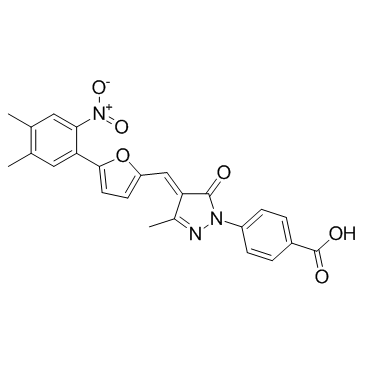C646

C646 structure
|
Common Name | C646 | ||
|---|---|---|---|---|
| CAS Number | 328968-36-1 | Molecular Weight | 445.424 | |
| Density | 1.4±0.1 g/cm3 | Boiling Point | 662.6±65.0 °C at 760 mmHg | |
| Molecular Formula | C24H19N3O6 | Melting Point | 224-226℃ | |
| MSDS | Chinese USA | Flash Point | 354.5±34.3 °C | |
| Symbol |

GHS09 |
Signal Word | Warning | |
|
Sp3/REST/HDAC1/HDAC2 Complex Represses and Sp1/HIF-1/p300 Complex Activates ncx1 Gene Transcription, in Brain Ischemia and in Ischemic Brain Preconditioning, by Epigenetic Mechanism.
J. Neurosci. 35 , 7332-48, (2015) The Na(+)-Ca(2+) exchanger 1 (NCX1) is reduced in stroke by the RE1-silencing transcription factor (REST), whereas it is increased in ischemic brain preconditioning (PC) by hypoxia-inducible factor 1 (HIF-1). Because ncx1 brain promoter (ncx1-Br) has five put... |
|
|
P300-dependent STAT3 acetylation is necessary for angiotensin II-induced pro-fibrotic responses in renal tubular epithelial cells.
Acta Pharmacol. Sin. 35(9) , 1157-66, (2014) To explore the signal transducer and activator of transcription 3 (STAT3) signaling pathway, especially STAT3 acetylation, in angiotensin II (Ang II)-induced pro-fibrotic responses in renal tubular epithelial cells.Rat renal tubular epithelial cell line (NRK-... |
|
|
Acetylation of glucokinase regulatory protein decreases glucose metabolism by suppressing glucokinase activity.
Sci. Rep. 5 , 17395, (2015) Glucokinase (GK), mainly expressed in the liver and pancreatic β-cells, is critical for maintaining glucose homeostasis. GK expression and kinase activity, respectively, are both modulated at the transcriptional and post-translational levels. Post-translation... |
|
|
Naphthoquinone-mediated inhibition of lysine acetyltransferase KAT3B/p300, basis for non-toxic inhibitor synthesis.
J. Biol. Chem. , (2014) Hydroxynaphthoquinone-based inhibitors of the lysine acetyltransferase KAT3B (p300), such as plumbagin, are relatively toxic. Here, we report that free thiol reactivity and redox cycling properties greatly contribute to the toxicity of plumbagin. A reactive 3... |
|
|
Acetylation regulates the stability of glutamate carboxypeptidase II protein in human astrocytes.
Biochem. Biophys. Res. Commun. 450(1) , 372-7, (2014) Glutamate carboxypeptidase II (GCPII) is known to be implicated in brain diseases such as schizophrenia and bipolar disorder, and dramatically increases in prostate cancer. Here, we investigated the regulation of GCPII expression in astrocytes and examined wh... |
|
|
Arsenic exposure causes epigenetic dysregulation of IL-8 expression leading to proneoplastic changes in kidney cells.
Toxicol. Lett. 237 , 1-10, (2015) Prolonged arsenic exposure has been shown to cause several detrimental effects in adults. However its effects following prenatal exposure are not well defined at the epigenetic level, particularly in terms of changes which may predispose an individual to adul... |
|
|
Regulation of MicroRNA 183 by Cyclooxygenase 2 in Liver Is DEAD-Box Helicase p68 (DDX5) Dependent: Role in Insulin Signaling.
Mol. Cell. Biol. 35 , 2554-67, (2015) Cyclooxygenase (COX) catalyzes the first step in prostanoid biosynthesis and exists as two isoforms. COX-1 is a constitutive enzyme involved in physiological processes, whereas COX-2 is induced by a variety of stimuli. MicroRNAs (miRNAs) are noncoding RNAs th... |
|
|
Paradoxical enhancement of fear extinction memory and synaptic plasticity by inhibition of the histone acetyltransferase p300.
J. Neurosci. 31(20) , 7486-91, (2011) It is well established that the coordinated regulation of activity-dependent gene expression by the histone acetyltransferase (HAT) family of transcriptional coactivators is crucial for the formation of contextual fear and spatial memory, and for hippocampal ... |
|
|
Virtual ligand screening of the p300/CBP histone acetyltransferase: identification of a selective small molecule inhibitor.
Chem. Biol. 17 , 471-482, (2010) The histone acetyltransferase (HAT) p300/CBP is a transcriptional coactivator implicated in many gene regulatory pathways and protein acetylation events. Although p300 inhibitors have been reported, a potent, selective, and readily available active-site-direc... |
|
|
p300 exerts an epigenetic role in chronic neuropathic pain through its acetyltransferase activity in rats following chronic constriction injury (CCI).
Mol. Pain 8 , 84, (2012) Neuropathic pain is detrimental to human health; however, its pathogenesis still remains largely unknown. Overexpression of pain-associated genes and increased nociceptive somato-sensitivity are well observed in neuropathic pain. The importance of epigenetic ... |